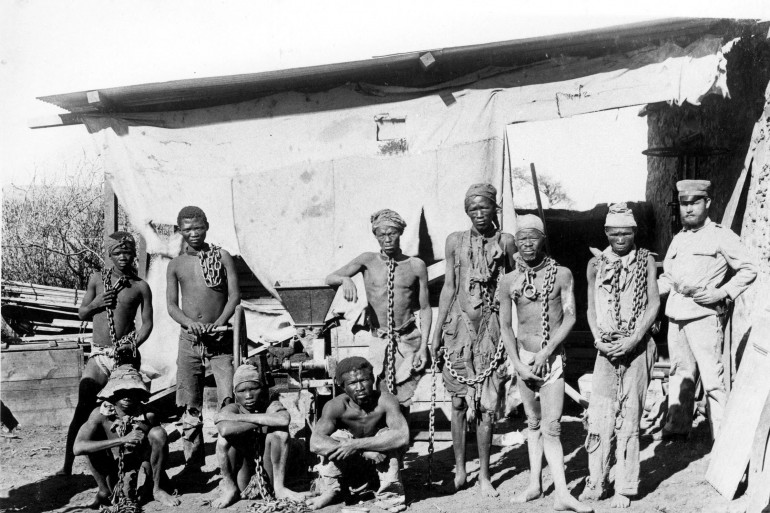
The Namibian Genocide: The Forgotten Crime of the 20th Century?
If Namibia is today a beautiful peaceful country endowed with an exceptional fauna and flora, it was not always so. Behind this heavenly landscape hides a sinister story.
Located in southwestern Africa, Namibia is geographically bordered to the west by the Atlantic Ocean, to the north by Angola, to the south by South Africa, to the east by Botswana and to the northeast by Zambia.
Its population density is the lowest in Africa, with a total population of 2,630,073 inhabitants for an area of 824,292 km2.
Like almost all the countries of the continent, Namibia did not escape colonization, and was the scene of one of the greatest forgotten crimes of the 20th century.
Since prehistoric times, several peoples have succeeded each other in the territory. First, it was inhabited by the San, nomadic people of hunter-gatherers who are the oldest inhabitants of southern Africa where they have lived for more than 40,000 years. They are gradually joined by the Khoikhoi, whose pressure leads them to find refuge in the Kalahari desert. The latter in turn, will be pushed back towards the second half of the 1st millennium, by the wave of Bantu expansion, mainly composed of Ovambos and Hereros.
In 1486, the Portuguese arrived on the Namibian coast. But due to the hostility of the climate, they ended up settling further north, in the territories that make up Angola today.
Around 1680, it was the turn of the Dutch to settle on the coast of Namibia. However, a few years later, the latter will favor the Cape region and the fertile lands of the South, in what will become today South Africa.
It was not until the 1820s that German missionaries established the first missionary posts in the territory. The missionaries find the country occupied by Hereros and Namas in constant war. Thus, they settled on the West Coast in 1878 and ended up colonizing the area. They then undertake a general mission of evangelization concerning the indigenous peoples which extends over several years. In 1884, the region officially became a German protectorate, called “German South West Africa”. German farmers and merchants gradually came to settle there.
The Hereros, exasperated at having lost their best land, prevented from practicing their transhumance, and also victims of a rinderpest which is decimating their livestock, find no other way out than confrontation. Samuel Maharero then raises his people alone against the German colonists on January 11, 1904. He attacks a garrison based in Okahandja and manages to destroy the German lines of communication, railways and telegraphs. Berlin informed, decides to react with unparalleled cruelty.
For five months, the repression was organized among the settlers, under the direction of Theodor Leutwein, then six warships were armed, under the command of General Lothar Von Trotha, which landed on June 11, 1904 in Swakopmund with large troops, about 15,000 soldiers from the Schutztruppe corps. In October, in an area located at the sources of Ohamakari, on a plateau called by the Germans the Waterberg, he surrounded the Hereros on three sides and machine-gunned them: it was a real carnage that spared neither women nor children. Trotha leaves them only one way out: the Kalahari Desert.
While the surviving Hereros try to find refuge there, Trotha poisons the water points, erects guard posts at regular intervals with orders to shoot without warning on sight every Herero, man, woman or child. General von Trotha’s official extermination order reads as follows: “Within the German borders every Herero, with or without a weapon, with or without cattle, will be shot. I will no longer accept women and children, I will send them back to their people or let them be slaughtered.”
The survivors are chained then transported towards 6 concentration camps created for this purpose by the Germans from January 1905. According to Serge Bilé, half of the prisoners would have died in captivity, that is to say 7,862 people. In 1905, many Namas were deported to Shark Island joining the Hereros. Nearly 2,000 Namas will have perished during this conflict either by arms, or as a result of ill-treatment, famine, forced labor, torture, or lack of care.
The war of extermination carried out by the German colonial troops between the years 1904 and 1908 resulted in the death of 80% of the Herero people, i.e. more than 65,000 people, more than half of the Namas people and a large part of the troops Damara and San ethnic groups, making it the first genocide of the 20th century. In 1911, there were officially 11,130 Hereros left, nearly 20% of the original population.
Namibia will gain independence on March 21, 1990, after having experienced a double dependence, first as a German colony called “German South West Africa” 1884-1915 then as a protectorate of South Africa until 1988.
It was in 1989 that South Africa accepted the independence of Namibia, by signing the Brazzaville Accords, in exchange for a definitive ceasefire. Elections are held a year later, and ratify the independence process. Samuel Nujoma, leader of SWAPO, thus becomes the first president in the history of the country.


Post a comment